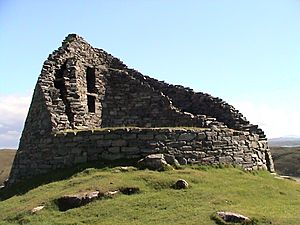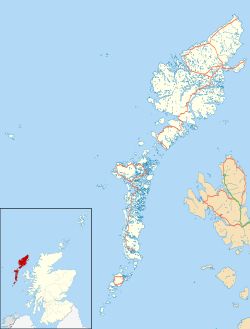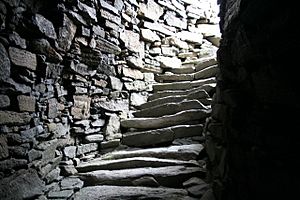Dun Carloway facts for kids

Dun Carloway
|
|
| Location | Isle of Lewis |
|---|---|
| Coordinates | 58°16′10″N 6°47′39″W / 58.269572°N 6.794104°W |
| Type | Broch |
| History | |
| Periods | Iron Age |
| Site notes | |
| Ownership | Historic Scotland |
| Public access | Yes |
Dun Carloway (pronounced 'Doon Car-LOW-way') is an amazing old stone tower called a broch. It's found on the west coast of the Isle of Lewis in Scotland. This ancient building is super well-preserved. Some parts of its original wall still stand as tall as 9 meters (about 30 feet)!
Contents
A Look Back: The History of Dun Carloway
Most brochs were built between 100 BC and 100 AD. Dun Carloway was likely built around the 1st century AD. Its name probably comes from the Norse language, meaning "Karl's bay." This shows it was once part of the Kingdom of the Isles, a time when Vikings were in charge. People lived in Dun Carloway for many years. They kept using it until the floor level became too high from layers of dirt and things left behind.
Dun Carloway as a Stronghold
Sometimes, in later years, the broch was used as a fort. For example, in 1601, a family called the Morrisons of Ness used Dun Carloway. The story says they had taken cattle from another family, the MacAuleys of Uig. The MacAuleys wanted their cattle back. They found the Morrisons hiding inside the broch.
One of the MacAuleys, Donald Cam MacAuley, was very clever. He climbed the outside wall using two daggers. Once he was up, he threw heather (a type of plant) into the broch and set it on fire. This made a lot of smoke, forcing the Morrisons to come out. After that, the MacAuleys damaged the broch.
Protecting a Historic Site
It seems that in the 1500s, most of the broch's walls were still standing tall. But by the mid-1800s, many stones from the top had been taken. People used these stones to build other things. A drawing from 1861 shows how much of the wall was gone by then.
To stop more damage, Dun Carloway became one of Scotland's first officially protected monuments in 1882. Five years later, the government took over its care. Since then, work has been done to restore parts of the broch. Small archaeological digs also happened in the early 1900s and the 1970s.
How Dun Carloway Was Built
Dun Carloway stands on a rocky spot, about 50 meters (164 feet) high, on a steep slope. It is the best-preserved broch in the Outer Hebrides. The wall on the south side of the broch still reaches 9.2 meters (about 30 feet) high. Only Mousa Broch and Dun Telve have taller walls. We don't know how tall Dun Carloway was originally. The broch looks out over Loch Carloway.
The outside of the broch measures 14.3 meters (about 47 feet) across. The inner courtyard, where people lived, is 7.4 meters (about 24 feet) wide. The walls are thick, ranging from 2.9 to 3.8 meters (9.5 to 12.5 feet).
Inside the Broch
The main entrance is on the north-west side. It is 75 centimeters (about 2.5 feet) wide and 1 meter (about 3.3 feet) high. On the south side of the entrance passage, there's a small side room called a "guard cell." Its opening is 61 centimeters (about 2 feet) square.
Inside the broch, there are three more openings:
- The opening on the eastern side, across from the entrance, leads to stairs. These stairs run between the inner and outer walls of the broch.
- The north-eastern opening (to the left of the stairs) leads to an oval room. Here, archaeologists found signs of at least three "peat ovens" used over many years.
- The western opening (to the right, after you enter) goes to a room located under the staircase.
You can see two large gaps in the south-eastern wall. On the north side of the inside area, the natural rock sticks out. It's likely there was a wooden floor above the ground level. A ledge, called a "scarcement," is visible 2 meters (about 6.5 feet) up. This ledge would have supported such a floor. Even though the remaining wall is over nine meters high, there's no sign of another ledge for a higher floor. This might mean there was only one upper floor, or they used a different way to build higher floors.
What Was Found Inside?
When archaeologists dug in the north-eastern room, they found at least three "peat ovens." These ovens were used between 400 and 700 AD. They also found many pieces of pottery, a part of a "quern-stone" (used for grinding grain), and a collection of snail shells.
The fireplaces in this room didn't have any animal bones. This suggests they weren't used for cooking meals. It's also unlikely they were used for making iron, because no metalworking tools were found. It seems the north-eastern room was mainly used for making clay pots.
Who Looks After Dun Carloway?
Dun Carloway has been looked after by the government since 1887. Today, it is owned by Historic Scotland. The visitor center nearby is run by Urras nan Tursachan, which means "The Standing Stones Trust."
See also
 In Spanish: Dun Carloway para niños
In Spanish: Dun Carloway para niños




